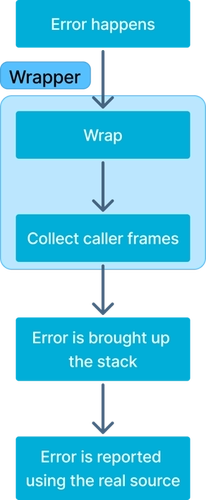Error handling
Introduction
Errors in Go can be a bit light on information, which makes it hard to find exactly what happened. Even more so when the error is reported on an error tracking service from a production environment.
The framework provides a convenient error wrapping mechanism in the package goyave.dev/goyave/v5/util/errors, which brings the following advantages:
- The callers are collected right when the error happens, allowing to precisely locate the exact origin of all errors.
- Multiple errors can be wrapped into one single error.
- Any error reason can be used, be it a
string, astruct, anothererror,map,[]error,[]any, etc. - More information can be attached to an error, which can be useful for use with error reporting services.
- The wrapper is handled by the structured logger, which results in more detailed logs. The error reasons are automatically converted to
slogattributes.- In dev mode, the error reason(s) and stacktrace(s) will be displayed in a format easily readable by humans.
- In production, the error reason(s) and stacktrace(s) will be marshaled into JSON and added to the resulting log entry.
- The
traceattribute will contain the stack frames. - The
messagewill contain the result of theError()function, which is the message of all wrapped errors joined by a line break (\n). - If the error reason is a custom error type implementing
slog.LogValuer, areasonattribute will be added and will contain the value returned byLogValue().
- The wrapper supports nested errors: it can wrap errors that wrap other errors.
Below is a diagram explaining the overall error wrapping flow:

Guidelines
panicis discouraged but can still be used in certain cases.- Any error returned should be wrapped using
errors.New().- If you are developing a library, you can use
errors.NewSkip()to skip the first stack frames and return a stack trace that points to the call of your library function instead of code inside your library.
- If you are developing a library, you can use
- Bring errors up the stack as much as possible, usually up the controller handler.
- Use
response.Error()to report the error. This will log the error and set the response status tohttp.StatusInternalServerError. In debug mode, the error will be written to the response body, otherwise the corresponding status handler will be executed.
func (ctrl *Controller) Show(response *goyave.Response, request *goyave.Request) {
err := ctrl.Service.SomeProcess()
if err != nil {
response.Error(err)
return
}
//...
}In the following example, we call HighLevelFunc() and expect someProcess() to return an error. Because we wrap the error as soon as it is returned, the stack trace will point precisely to where the error originates from.
import (
//...
"goyave.dev/goyave/v5/util/errors"
)
func HighLevelFunc() error {
err := SomeFunc()
if err != nil {
return errors.New(err)
}
//...
return nil
}
func SomeFunc() error {
value, err := someProcess()
if err != nil {
return errors.New(err) // Trace will point to here
}
//...
return nil
}INFO
- When
errors.New()receives a reason that is already wrapped (*errors.Error), the reason is returned without change. The trace is therefore not modified and no information is lost. - It is however a good practice to always use the wrapper, so you are certain your errors are always wrapped at some point.
errors.New(nil)returnsnil. If the reason is[]erroror[]any, thenilelements are ignored.*errors.Error.Error()returns the error message only without the stack trace. If you are using this type outside of the framework's slogger context, prefer using*errors.Error.String().
Recovery middleware
Goyave has a built-in global middleware that ensures all unrecovered panic are gracefully recovered. When this middleware recovers from a panic, it will wrap it if not already wrapped, then log it. Finally, the response status is set to http.StatusInternalServerError, and the status handler for this code is executed.
This mechanism ensures the resilience of your application, because a proper response will always be sent to the client. Moreover, it helps solving unexpected panics thanks to the same precision a regular wrapped error would have.
Status handler
When an error is generated inside the request lifecycle, be it from a panic recovered by the recovery middleware or an error reported with response.Error(), the status handler associated with the 500 status code will be executed.
The default status handler for errors can be replaced with your own, letting you handle errors in a centralized way. This is helpful if you want to report your errors to an error tracking service.
// http/controller/status/status.go
type PanicStatusHandler struct {
goyave.Component
}
func (*PanicStatusHandler) Handle(response *goyave.Response, _ *goyave.Request) {
errortracker.Notify(response.GetError())
message := map[string]string{
"error": http.StatusText(response.GetStatus()),
}
response.JSON(response.GetStatus(), message)
}WARNING
- Don't forget a
*errors.Errormay wrap several errors. To make sure all the wrapped errors are properly reported in your error tracker, make use oferr.Len()anderr.Unwrap(). - Although
*errors.Errorimplements methods frequently used by error reporting services, such asCallers() []uintptr, and should work out-of-the-box with many of these service, the one you are using may not. Make use oferr.FileLine(),err.StackFrames(),err.Callers()to feed your error tracker all the information it needs.